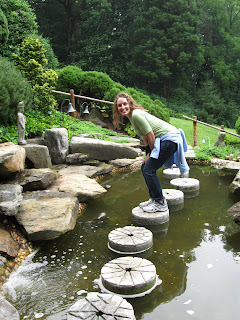I think it's a pretty tough call, to pick a favorite workplace between the water lilies/hibiscus/rose house and the orchids... I worked the majority of the past week with Tim and Ed, and I gained an enormous amount of knowledge about plants I've never grown before. The hibiscus are beautiful plants, they are so successful with them here at Longwood. I love the gorgeous cultivar, "Dark Night." Ed tests the soil pH once a week, because hibiscus are pH sensitive, and they also have the soil lab tested frequently. Hibiscus flowers are short-lived, only blooming a few days at best, and they're open at night as well. I want to learn more about the roses, and I will have a lot of opportunity to ask questions about roses next week when we do a huge pruning job on them. Each summer they are forced into dormancy, so as to not detract attention from the outdoor roses. It also gets really hot in that house during the summer. The roses currently have a huge aphid problem (some cultivars much worse than others...I wonder what the factor is that sets them apart.), but it's not worth treating them with anything more than a blast of water now because the cutback is coming up soon. They are quite beautiful, though, and very fragrant. Tim told me that Pierre du Pont built the rose house so that he would have a year-round supply of cut flowers, as he did so much entertaining.
The water lilies are so much fun! First of all, they're so beautiful and exotic, it's quite easy to love working on them. Also, I love working with plants and talking to people (instead of being cooped up in a greenhouse), and the water lily pools are a huge attraction in the conservatory. People are constantly asking questions when we're in the pools, and they are facinated by the work we're doing. The tropical lilies sit up higher above the water, have more fragrant blooms, and have more intense colors than the hardy lilies. The hardy lilies are beautiful as well, but I notice they have smaller (but more numerous) leaves than the tropicals. The lily bud comes up from the crown of the plant and opens with a lovely perfume and nectar in the well of the flower. This attracts a bee, beetle, or other bug, which falls into the well to get the nectar. In such a fuss for the insect to get out, the pollen from the anthers gets knocked into the liquid. The next time that the flower opens, the nectar has drained somewhat, causing the pollen to come into contact with the stigmatic portion of the flower, where pollination can occur. The flowers can be classified easily as "first day," "second day," "third" or "fourth-day flowers," based upon the position of the anthers and petals, the presence of nectar, and it's height in the water. The expired blooms retreat back underwater after the fourth day. One of our jobs in the pools is to remove old flowers, and this is an easy task because they give themselves away with a squeeze. If water comes out of the tip of the closed flower, it has already bloomed. The small leaves of the lilies are removed just as suckers are taken off to focus growth on larger leaves and flowers.
I have learned also about the lotus plant, especially about the "nano-technology" of the leaves. Water immediately beads up on the leaf surface and rolls off. The lotus is propagated at Longwood yearly by the tubers that are produced. Also, never cut the stem of the lotus leaf under the water: the "air tubes" in the stem can become flooded with water, and will eventually drown the plant. The bogs contain a lot of interesting plants like water lettuce, water hyacinth, parrot's feather plant, taro, canna, and ruellia.
I am very interested in the research that is performed here at Longwood on the giant water platters, Victoria. They grow in the Amazon and S. America, and a very special hybrid was created here (originally by Patrick). The cross is between V. crusiana and V. amazonica. So beautiful! They have vicious spines on the leaves and petioles, to protect themselves from nibblers, and the leaves can grow up to 8 feet in diameter! They can hold up to 125 lbs!!! with the support of plywood or other such material to distribute the weight. The leaves come up to the surface in their full-grown size, so right now (at the beginning of their "season," they were planted in May) the small leaves are being removed. The nocturnal blooms are only 2-nightflowers: the first night, they are white and smell of pineapple, and the female portion of the flower is dominant. The second night, the bloom is pink-red and the male portion is dominant. Ed says that this is to ensure that inbreeding and inferior mutations are avoided. Cross-pollination occurs because the male and female organs are not functioning on the same plant at the same time. Amazing!
Below is a picture of Ed, Tim, Gavin, and me moving the huge Victorias to the nursery pond. This involved removing them from the tanks in the greenhouse, carefully wrapping them in paper and cloth to keep them hydrated, moving them by cart to the truck, then unloading them into the water. This was a very careful operation since the leaves and petioles do not support themselves upward like a non-aquatic plant. It was very fun! The waders are great, they make me fearless to jump right in--literally! :)











